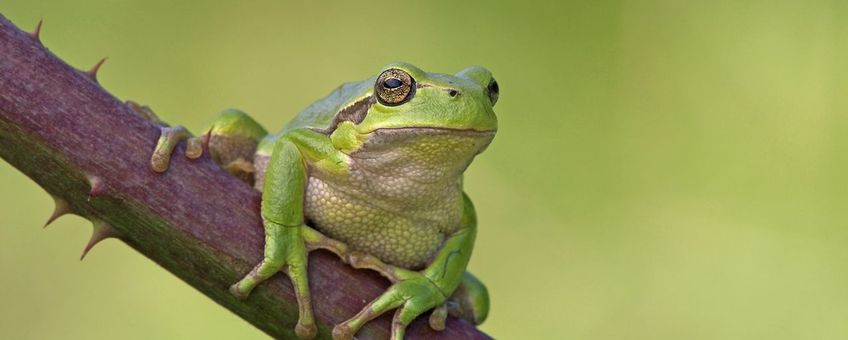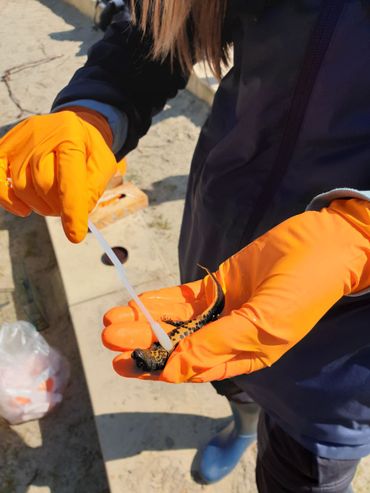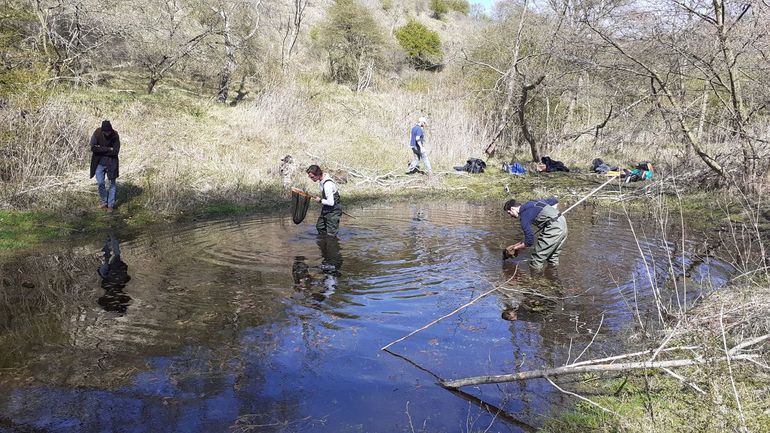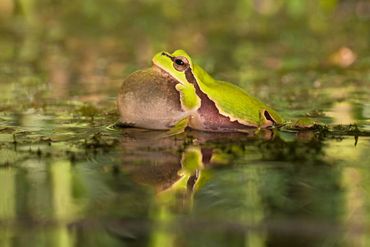
In collaboration with RAVON (Reptile, Amphibian & Fish Conservation Netherlands) and Naturalis Biodiversity Center, eight biology students investigated the origin of several amphibian populations in the Dutch dune landscape. It was suspected that these dune populations were of foreign origin because they occur in an unusual location - far away from the natural populations - and have only been discovered relatively recently.
Dip nets and waders

Under the supervision of researchers Ben Wielstra and Richard Struijk, the team ventured into the dunes armed with dip nets and waders. The team took a bit of saliva or skin mucus from each animal with a cotton swab. From this, the team was able to isolate DNA and precisely reconstruct the order of the DNA-letters. The technique they used is called DNA-barcoding.
DNA-barcoding is a fast and convenient technique to identify DNA-profiles. The DNA-profile holds information about the identity of a species and shows from where in its natural range the ancestors of an introduced population were originally derived. You can compare it with languages and accents. By the language someone speaks, you can usually tell from which country that person is. By the accent, you can tell from which region exactly.
Croaking invaders
One of the amphibians the biology students studied, was the tree frog. This frog belongs to a group of 'cryptic species'. These are species that look alike, but turn out to be very different according to their DNA. The students compared DNA from the dune populations with other tree frog populations from The Netherlands and the rest of Europe. The result? The Eastern tree frog, originating from Greece, was found in the National Park Hollandse Duinen. In addition, they also found the Italian tree frog in the Westduinpark near The Hague. These species are genetically very different from the European tree frog, which is native to The Netherlands.

The odd one out
These are not the only exotic amphibians the team identified. A population of spadefoot toads was discovered in the dunes near Callantsoog, which does not belong there either. “Spadefoot toads naturally only occur in the south and east of The Netherlands. The DNA profile shows that the population in Callantsoog is the same species as in The Netherlands, but is genetically dissimilar from the Dutch populations”, says Nienke Prins, one of the students who studied this population. “The DNA profile points to an origin in Eastern Europe.
The midwife toad has also certainly been released in the dune area. In The Netherlands, this species lives exclusively in South Limburg. Furthermore, the presence of great crested newts is suspicious, but debatable: it could be a remnant population from a distant past. "The DNA-profile of these two species appears to occur naturally in many European countries, including The Netherlands", explains Ph.D. candidate Manon de Visser, who helped supervising the students. "It is therefore difficult to determine their origin. We will have to conduct more DNA-research to crack those codes.”


Exotic misery
Does it matter where these species originally come from? “Yes”, says Struijk firmly. “Exotic species are one of the greatest threats to nature and can cause a lot of damage. If this is the case, the species can be seen as invasive. Exotic species can displace native species, for example, because they compete with or prey on native species", he mentions as one of the problems. Wielstra adds: “Exotic species can also carry nasty pathogens, such as fungi that cause the infectious disease chytridiomycosis. This is a disease that has killed many amphibians already.” The research team's advice is therefore clear: "Keep an eye on these suspicious populations, do everything we can to identify new exotic populations as quickly as possible, and recognize the danger of introduced populations."
More information
Articles
- The introduction of three cryptic tree frog species in the Dutch coastal dunes challenges conservation paradigms, written by M. Kuijt en anderen, published in Amphibia-Reptilia in 2022.
- The conservation paradox of an introduced population of a threatened species: spadefoot toads in the coastal dunes of the Netherlands, written by S. Koster en anderen, published in Amphibia-Reptilia in 2022.
- An isolated crested newt population in Dutch coastal dunes: distribution relict or introduction?, written by J. de Brouwer en anderen, published in Amphibia-Reptilia in 2022.
- The limits of mtDNA barcoding for determining the provenance of invasive species: a midwife toad example, written by C. Vliegenthart en anderen, published in Amphibia-Reptilia in 2022.
- Biology students expose exotic amphibians in the dunes.
Manon's DNA Talk (YouTube video's)
Student projects
The four student projects were carried out by the Institute of Biology Leiden (IBL) and Naturalis Biodiversity Center, in close collaboration with RAVON (Reptile, Amphibian & Fish Conservation Netherlands). ARTIS, Dunea, Natuurmonumenten, Staatsbosbeheer and the municipality of The Hague facilitated sampling. The articles are published in the journal Amphibia-Reptilia. The following students were in the different project groups:
Tree frog: Marit Kuijt & Liam Oskam
Spadefood toad: Stephanie Koster & Nienke Prins
Midwife toad: Chris Vliegenthart & Maurits van de Vrede
Crested newt: Jurian de Brouwer & Bas Helder
Text: Nienke Prins, Ben Wielstra & Manon de Visser, Leiden University & Naturalis Biodiversity Center and Richard Struijk, RAVON
Pictures: Jelger Herder; Manon de Visser; Nienke Prins
